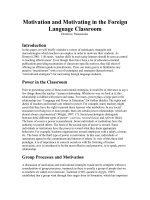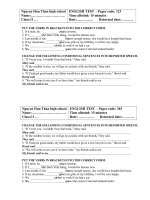segmentation targeting and positioning in bm
Bạn đang xem bản rút gọn của tài liệu. Xem và tải ngay bản đầy đủ của tài liệu tại đây (570.83 KB, 13 trang )
12/09/2012
1
Chapter 4
Segmentation, Targeting and
Positioning in B.M
www.dinhtienminh.net
Đinh Tiên Minh
Th.S Đinh Tiên Minh
Objectives
2
Know market segmentation, its benefits and
limitations, and requirements of effective
segmentation.
Learn to select the target market segments
and target-market strategies.
Learn to develop effective positioning
strategies.
12/09/2012
2
Th.S Đinh Tiên Minh
Outlines
4.1 Market Segmentation
4.2 Selecting the Target Segments
4.3 Positioning
3
Th.S Đinh Tiên Minh4
4.1. Market segmentation
Definition: Market segmentation is the
process of dividing a market into groups of
customers who have similar requirements for
a product or service offering.
Nguồn: Krishna K Havaldar (2010), Business Marketing, McGraw Hill, 3rd
edition, p42
12/09/2012
3
Th.S Đinh Tiên Minh5
4.1. Market segmentation (cont’)
Segmenting and Targeting Framework
Conduct Marketing research to collect data on
buying firms and competition
Identify Macro-segments based on analysis of data
Select those Macro-segments which satisfy
company objectives and resources
(More)
6
4.1. Market segmentation (cont’)
Nguồn: Yoram Wind & Richard Cardozo, “Industrial Market Segmentation”, Industrial Marketing Management, 3, 2, (April, 1974), pp 153-66.
If yes, select the target
Macro-segments based
on specific criteria
Stop, and use the Macro-
segments as target
segment
Evaluate each selected Macro-
segment on whether it explains the
differences in buying decision.
If no, identify within each Macro-
segment, meaningful Micro-
segments.
Select the target Micro-segments
based on earlier specified criteria
Profile target segments based on
buying organization and Decision
Making Unit characteristics
12/09/2012
4
Th.S Đinh Tiên Minh9
4.1. Market segmentation (cont’)
Benefits, Limitations and Requirements of
effective segmentation:
What are the Benefits?
• Enable to compare marketing opportunities of
different market segments (needs, competition,
satisfaction levels).
• Develop separate marketing programs or plans.
• The budgeted allocation of resources can be done
effectively.
Th.S Đinh Tiên Minh10
4.1. Market segmentation (cont’)
Benefits, Limitations and Requirements of
effective segmentation (cont’):
What are the Limitations?
• Increase in marketing expenses (inventory carrying
cost, adv, transportation…).
• Difficulty in segmenting due to existence of great
differences in buying practices, customer
characteristics, product applications…
12/09/2012
5
Th.S Đinh Tiên Minh11
4.1. Market segmentation (cont’)
Benefits, Limitations and Requirements of
effective segmentation (cont’):
What are the Requirements?
• Measurable
• Substantial
• Accessible
• Differentiable
Th.S Đinh Tiên Minh16
4.2. Selecting the target segments
After evaluating several market segments,
the company must select its target
segments by using the Simple Matrix
System (SMS) method.
12/09/2012
6
Th.S Đinh Tiên Minh17
4.2. Selecting the target segments (cont’)
Simple Matrix System (SMS)
Segments
Factors
Automotive
Bicycle
Boiler
Furniture
Bus body
Building
Size (US
million)
600
500
300
250
200
Growth (in %)
20
10
10
7
10
Profitability
Good
Good
Good
Low
Low
No. of
competitors
3
4
3
10
8
Major
competitors’
strengths
Product
quality and
timely
delivery
Product
quality
and
timely
delivery
Availability
of special
raw material
with 2
competitors
Low prices
from small-
scale
manufacturers
Low prices
from small-
scale
manufacturers
Th.S Đinh Tiên Minh18
4.2. Selecting the target segments (cont’)
Nguồn: Krishna K Havaldar (2010), Business Marketing, McGraw Hill, 3rd edition, p152.
Major
competitors’
weaknesses
Customer
service
Customer
relationship
Except 2
other
competitors
did not have
raw material
Mainly
supplied by
small-scale
manufactur
ers
Mainly
supplied by
small-scale
manufacture
rs
Company
strengths
Customer
service and
relationship
Customer
service and
relationship
___
___
___
Success factor
Large volume
production and
technically
complex product
Large volume
production and
technically
complex
product
Availability of
special quality
raw material
Simple
product, low
price
Simple
product, low
price
Compatibility
with company’s
long-term
objectives
High
Average
Low
Low
Low
12/09/2012
7
Th.S Đinh Tiên Minh19
4.2. Selecting the target segments (cont’)
Target market strategies
Whole market
CMS
Undifferentiated
marketing strategy
Nguồn: Krishna K Havaldar (2010), Business Marketing, McGraw Hill, 3rd edition, p154.
MS1 MS2 MS3 MS4 MS5
P1
P2
P3
P4
CMS
I
CMS
II
CMS
III
CMS
IV
CMS
V
Differentiated marketing
strategy
MS1 MS2 MS3 MS4 MS5
P1
P2
P3
P4
CMS
Concentrated marketing strategy
P: Product; MS: Market Segment; CSM: Company Marketing Strategy
Th.S Đinh Tiên Minh20
4.2. Selecting the target segments (cont’)
Target market strategies
Undifferentiated Marketing
• Developing a single marketing plan or program that
will be common to all segments or customers.
• This strategy may be a conscious strategic decision
due to standardized products or services sold to the
market where there is no differentiation among the
customers.
12/09/2012
8
Th.S Đinh Tiên Minh21
4.2. Selecting the target segments (cont’)
Target market strategies
Differentiated Marketing
• Deciding to target several market segments whose
needs, product usages or market responses are
appreciably different
• This increases overall costs but achieves higher
sales volume and a stronger position in the chosen
markets.
Th.S Đinh Tiên Minh22
4.2. Selecting the target segments (cont’)
Target market strategies
Concentrated Marketing:
• Focusing all the marketing efforts on a single or
relatively few, carefully defined-segments.
• Ex: Material handling equipment manufacturer
decided initially to segment the market based on
“customer location” to be able to give superior pre-
sales and post-sales services than competitors.
12/09/2012
9
Th.S Đinh Tiên Minh23
4.3. Positioning
Definition: Positioning is defined as a distinct
place a product/ service occupies in the minds of the
target customers relative to competing products/
services.
Nguồn: Krishna K Havaldar (2010), Business Marketing, McGraw Hill, 3rd edition, p156.
Ries & Trout call positioning as the battle for the
customer’s mind.
Nguồn: Al Ries & Jack Trout, Positioning. The battle for your mind, 1
st
edition, New York:
Warner Books, 1986.
Th.S Đinh Tiên Minh24
4.3. Positioning (cont’)
Three critical components in writing
positioning statements:
Target: The characteristics of the target
customers in which the supplier is interested.
Offering concept: The absolutely necessary
attributes for the target customers.
Value proposition: The difference of the market
offering compared to the next-best alternative
offering that is valuable to the target customers.
Nguồn: Anderson and Narus.
12/09/2012
10
Th.S Đinh Tiên Minh25
Exemple of Value Proposition
Why should I buy the product/ service from
you instead of from your competitors?
Giving sound reasons on how target customers will
be more benefited by using the supplier’s brand.
Claim support is sometimes needed such as ISO
certification to differentiate the superior product
quality from that of competitors.
Th.S Đinh Tiên Minh26
4.3. Positioning (cont’)
Criteria to select best positioning statement:
1. It should be meaningful for both target
customers and the supplier firm people.
Exemple:
Oracle’s positioning statement: “We offer better
solutions”.
Gati transport company: “On time, Every time”.
Nguồn: George P. Dovel, “Stake it out: Positioning Success, Step by Step”,
Business Marketing (July, 1990), pp48-51.
12/09/2012
11
Th.S Đinh Tiên Minh27
4.3. Positioning (cont’)
Criteria to select best positioning statement:
2. It should convey the value proposition that is
accurate, real and convincing for the target
customers.
Nguồn: George P. Dovel, “Stake it out: Positioning Success, Step by Step”,
Business Marketing (July, 1990), pp48-51.
Th.S Đinh Tiên Minh28
4.3. Positioning (cont’)
Criteria to select best positioning statement:
3. It should be consistent with what the
organisation is trying to achieve (All concerned
people should be committed to deliver the value
proposition to the target customers).
Nguồn: George P. Dovel, “Stake it out: Positioning Success, Step by Step”,
Business Marketing (July, 1990), pp48-51.
12/09/2012
12
Th.S Đinh Tiên Minh29
4.3. Positioning (cont’)
Criteria to select best positioning statement:
4. It should be the basis of communication message
through advertising, sales promotion and sales
presentations.
Nguồn: George P. Dovel, “Stake it out: Positioning Success, Step by Step”,
Business Marketing (July, 1990), pp48-51.
Th.S Đinh Tiên Minh30
4.3. Positioning (cont’)
Procedure for developing a positioning
strategy:
Identifying the major attributes for differentiation
(Product, Service, Personnel, Image variable).
Selecting the differentiating attributes.
Communication the company’s positioning.
12/09/2012
13
Th.S Đinh Tiên Minh31
Example of Two-dimentional Perceptual Map
-0.2
Excellent
product
quality
1.0
0.8
0.6
0.4
0.2
-0.2
-0.4
-0.6
-0.8
-1.0
Low
product
quality
Weak
customer
service
Strong
customer
service
1.0
-1.0
0.8
-0.8
0.6
-0.6
0.4 -0.40.2
B
D
C
A
A1
www.dinhtienminh.net









